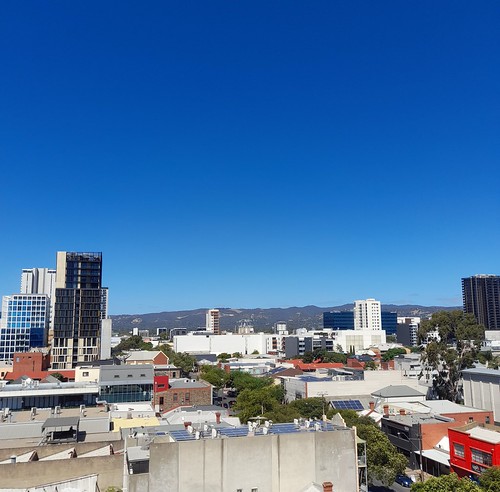Adelaide Has Some of Australia’s Best Aboriginal Cuisine — Here’s Where to Eat
Adelaide #Adelaide

In Adelaide, Australians are waking up to the Aboriginal roots of their local cuisine.
JONATHAN VAN DER KNAAP/COURTESY OF RESTAURANT BOTANIC
Dessert at Restaurant Botanic, in the Adelaide Botanic Garden, comes in the form of chilled Redlove apple served with riberries.
“This is a macadamia tree,” said Haydyn Bromley, gesturing toward a cluster of dark green leaves as we walked through the Adelaide Botanic Garden. “They’re native to Australia.” I was surprised — I had always associated the nut with Hawaii. Bromley, the cultural director of the Aboriginal-owned and -operated consultancy Bookabee Australia, was introducing me to some of the endemic plants that grow in this 124-acre park in South Australia. Indigenous clans, he told me, were the first people to eat macadamias; they also used macadamia oil for skin rejuvenation and body paint.
Macadamias are just one of approximately 6,000 foods that have been eaten by Australia’s Indigenous peoples for at least 65,000 years. Known as “bush tucker,” this nutrient-rich cuisine includes any native food source: nuts, fruits, and vegetables, of course, but also seafood like marron, or Australian crayfish; land animals such as emu and kangaroo; and insects like green ants and witchetty grubs, large white larvae that transform into wood moths.
Courtesy of Adelaide Central Market
Something Wild founder Daniel Motlop at his stall in Adelaide Central Market.
Many of these endemic resources were erased from mainstream culinary culture during European settlement in the late 18th century, after which imported provisions were gradually adopted. “People used to think Aboriginal sustenance was just grubs and snails,” Bromley told me.
Related: Exploring What It Means to Be an Aboriginal Australian Today
Now more menus reflect hyperlocal gastronomy as Australians take greater interest in Aboriginal culture and chefs celebrate previously unlauded ingredients for their nutritional value and sustainability — and for their flavor. “Bush tucker has quickly begun moving into the national diet for the last ten years,” said leading Aboriginal horticulturist Clarence Slockee. “Everyone wants to know where their meals come from.”
Adelaide, which is located on unceded Aboriginal Kaurna land, has a variety of places to try these foods, from haute tasting menus to market stalls. Check out these four to experience it for yourself.
Bush Devine
At Paulett Wines, located in the Clare Valley wine region about 85 miles north of Adelaide, owner Ali Paulett planted a bush garden with the guidance of Aboriginal consultants back in 2010.
Today, the winery’s restaurant, Bush DeVine, continues that focus on local farming. Chef Thomas Erkelenz sources ingredients from his on-site garden and also relies on relationships with regional foragers and purveyors.
I ate soba noodles made with sweet-spicy pepperberries, accented with pork cracklings and a briny succulent called karkalla, on a terrace overlooking pastures and vineyards.
JONATHAN VAN DER KNAAP/COURTESY OF RESTAURANT BOTANIC
Eggplant and Tunu dish at Restaurant Botanic
Red Ochre Barrell & Grill
Located on the banks of the Torrens River in the suburb of North Adelaide, this was the first restaurant to showcase only-in-Australia foods when it opened 24 years ago. “Our most popular dishes are the grilled kangaroo, the fried crocodile fish cakes, and the pan-roasted barramundi,” said executive chef Ray Mauger, who sources from Indigenous co-op farms whenever possible. When diners show interest in bush tucker, the staff hands them an illustrated list that describes 20 of the most common ingredients they might encounter, from spinach-like warrigal greens to rosella flowers, a type of edible, antioxidant-rich hibiscus that packs a berry-rhubarb flavor.
My entrée of grilled kangaroo (a gamy, lean meat with higher levels of protein and iron than beef) was flavored with quandong, a wild peach favored for its nutrition and medicinal uses. For dessert: a panna cotta of lemon myrtle and sunrise lime, an oval fruit that tasted a bit like a kumquat.
Jonathan van der Knaap/Courtesy of Restaurant Botanic
The dining room at Restaurant Botanic in Adelaide
Restaurant Botanic
In a gazebo-like space in the middle of the Adelaide Botanic Garden, executive chef Justin James orchestrates a wildly inventive four-hour, 29-course tasting menu that includes at least 30 native ingredients. He serves emu meat that has been cured with sunrise limes; tops oysters from Coffin Bay, a seafood haven in South Australia, with fermented desert-lime pulp and green ants; and wraps marron in leaves of a shrub called oldman saltbush. The presentation is theatrical, with dishes perched on leaves, tucked into shrubbery, skewered on branches, wrapped in tree bark, and resting on rocks that are meant to be licked to heighten the umami flavor profile. Even the sparkling wine is flavored with lemon aspen and mountain pepperleaf, two Indigenous botanicals.
Something Wild
This Aboriginal-owned company, which has a stall in the bustling Adelaide Central Market, sources directly from Indigenous vendors. Under founder Daniel Motlop, the team sells dry goods like bush teas, spices, and rubs, as well as a wide range of wild-harvested fresh produce, including Kakadu plums and bush apples, fruits that look like small pomegranates. Jars of pickled succulents and quandong jam line the shelves, and the refrigerated display case holds cuts of wild boar, emu, crocodile, and kangaroo. The green-ant gin is one of Something Wild’s most popular products, and the lemon-myrtle tarts, sprinkled with crunchy ants, are a mouth-puckering flavor blast.
Courtesy of Bush DeVine Winery Restaurant
Tasting menu at Bush DeVine Winery Restaurant
A version of this story first appeared in the August 2023 issue of Travel + Leisure under the headline “Natural Selection.”
For more Travel & Leisure news, make sure to sign up for our newsletter!
Read the original article on Travel & Leisure.